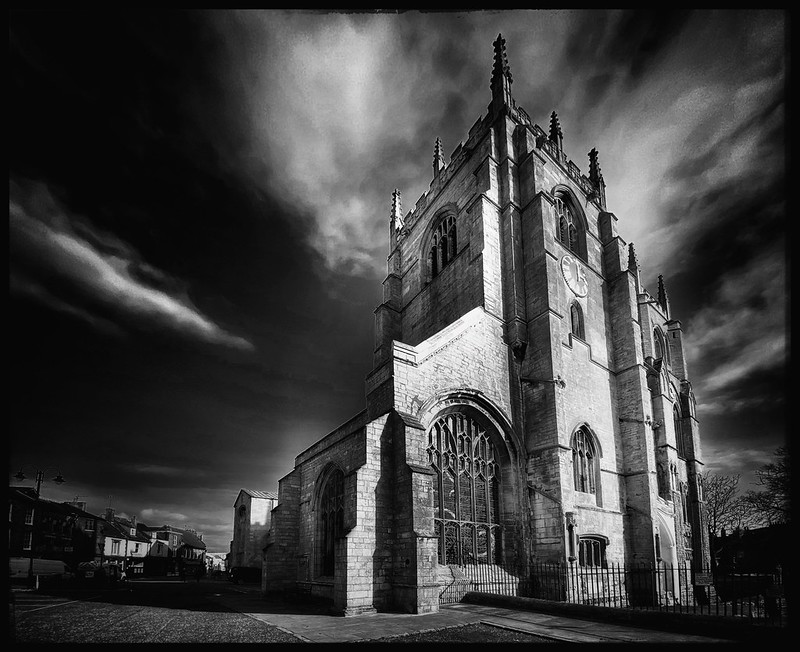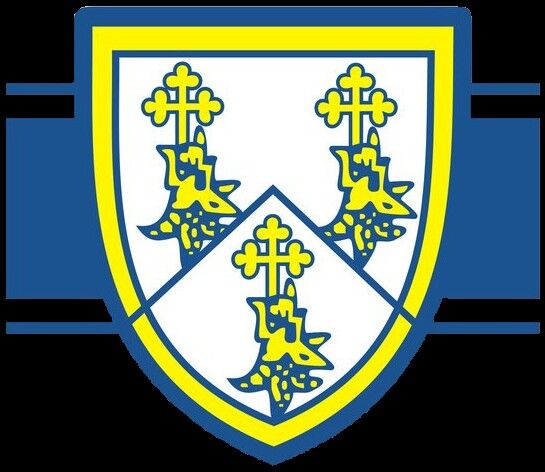We all have three lives: a public life, a private life, and a secret one.
Gabriel García Márquez

The novelist García Márquez once said that we all have three lives: a public life, a private life, and a secret one. People may be skilful at keeping their private and secret lives hidden, but buildings are often unable to do that, especially once the records come into the public domain for the historian to discover.
Things are not always as they appear.
The parish church of King’s Lynn (St Margaret’s) is a respectable building that sits grandly opposite the Town Hall and Trinity Guildhall and has an imposing historical and religious presence. The church was even granted the title of King’s Lynn Minster in 2011 by the Bishop of Norwich. Despite the civic, theological, and genuine architectural grandeur, the building has a few significant secrets that are at variance with its solid respectability.
The Sinner: Herbert de Losinga
It started with the sinner in the 1090’s.
Herbert de Losinga, Abbot of Ramsey in 1088, let it be known to William II that if he, Herbert, were to be appointed to the see of Thetford and his father to the Abbacy of Winchester, his gratitude would be significant and tangible. After the king had made the desired appointments de Losinga deposited the huge sum of £1,900 into the Treasury.
So far so good, except …
Today we may disapprove of individuals making generous donations to political parties in order to gain a seat in the House of Lords, but we are so used to it that it tends to get lost in yesterday’s news. However, the problem for de Losinga was that yesterday’s news didn’t go away – in fact, it lasted for eternity.
Using money to gain power or ecclesiastical office was regarded as a serious sin by the Roman Catholic Church (Acts 8:9-25). Although de Losinga may have been able to keep his actions hidden from a great number of common people, enough people knew he had committed this sin for him to be worried. He knew that according to Catholic doctrine, he was risking extra years spent in purgatory after his death. In fact, de Losinga was so worried that he travelled to Rome in 1094 to resign his office.
The pope accepted de Losinga’s resignation and granted him absolution, but immediately reinstated him in another job and another task.
In 1095 (the year after meeting de Losinga in Rome) Pope Urban II stood in pulpit in Claremont in France and told Christian knights that if they wanted to earn time off purgatory they should go on a crusade and recapture Jerusalem from the alleged infidel. That was to happen after Herbert’s visit to him in Rome, but given all sorts of people joined the crusades, it may have been a possibility in Urban’s thinking.
However, on receiving de Losinga’s resignation Urban told him he was to leave Thetford and become Bishop of Norwich and that as part of his penance he was to give more money – this time to the church – and use it to build other churches and religious houses.
De Losinga obeyed and provided funds for the first buildings of St Nicholas at Great Yarmouth, St Margaret’s in Lynn (1095), and Norwich Cathedral. In order to encourage the citizens of Lynn to contribute to the costs of building, he granted donors indulgence for 40 days (time off from punishment in purgatory after death).
The Dragon who Swallowed Margaret of Antioch
St Margaret’s in Lynn is dedicated to St Margaret of Antioch. St Margaret was the patron of pregnancy and childbirth, dying, and kidney diseases, and the falsely accused.
Margaret was born a pagan during the reign of the Roman emperor Diocletian (284–305), but became a Christian through the nurse who brought her up as her own mother had died after Margaret’s birth. Margaret decided to dedicate her virginity to God and when she was 15, refused the determined Olybrius who wanted to marry her. When she refused to give up her faith and marry him she was imprisoned and tortured.
In one of her tortures Satan appeared to her disguised as a dragon and then swallowed her up. However, Margaret was able to use her cross to irritate Satan’s stomach and she was disgorged. She survived later attempts to drown or burn her, but was eventually beheaded in 304.

Interest in St Margaret was revived during the Crusades (partly because of the Crusaders’ travel to, and through, Antioch) and she became particularly popular during the Middle Ages. Prayers to her were said to be particularly efficacious which may explain her renown. Her voice was one of those claimed to have been heard by Joan of Arc.
King’s Lynn’s town crest today contains a small shield with three dragon heads with a cross in their mouths because of St Margaret’s story.
So far so good, except …
There have always been many doubts surrounding Margaret’s story. Her legend had been declared apocryphal by the Pope as early as 494 and in the thirteenth century Jacobus de Voragine noted that the story was too fanciful for most priests. In 1969 Margaret’s feast day (July 20) was eliminated in the revised calendar of the Roman Catholic Church because it is doubtful whether she ever existed.
So
So, the great structure of St Margaret’s, which has been rebuilt over the years, and which has housed the worship of the faithful, was partially paid for by a man who sinned by using money to get his own way and who was then ironically told to use it again to get someone else’s way; and one of the results was dedicated to a fictional dragon-escapee. And a respectable Norfolk town now has three vomiting dragons on its crest.
Book a Walk with a Trained and Qualified King’s Lynn Guide
Sources
- Dresvina, J. (2012) The Significance of the Demonic Episode in the Legend of St Margaret of Antioch, Medium Ævum, LXXXI No 2
- Goulburn, E.M. and Symonds, H. (2018) The Life, Letters, and Sermons of Bishop Herbert De Losinga: The Letters (As Translated by the Editors) Being Incorporated With the Life, and the Sermons Being Now First Edited From a MS in the Possession of the University of Cambridge, Franklin Classics
- Hillen, H.J. (1907) History of the Borough of King’s Lynn, Vol.1, EP Publishing Ltd.
- Larson, W.R. (2000) Three Thirteenth Century Lives of St Margaret of Antioch, in Head, T. (ed.) Medieval Hagiography: An Anthology, Garland Publishing
- Mackerell, B. (1738) The History and Antiquities of the Flourishing Corporation of King’s Lynn in the County of Norfolk, Available from the University of Michigan Libraries, https://ia802606.us.archive.org/14/items/historyandantiq00mackgoog/historyandantiq00mackgoog.pdf
- White, C.H.E. (accessed April 2021) Dictionary of National Biography, 1885-1900/Losinga, Herbert de, https://en.wikisource.org/wiki/Dictionary_of_National_Biography,_1885-1900/Losinga,_Herbert_de
© James Rye 2021

[…] reminders of the attack. On 3 September a cannon ball came in the window above the west door of St Margaret’s church, broke part of a pillar into many pieces. Nobody was hurt but five people had a narrow escape when […]
[…] 1643 the Earl of Manchester entered the town with his Life Guards and attended a service at St Margaret’s Church. He set up his headquarters with Thomas Toll at his […]
[…] commercial estate (significantly inside the town wall, next to the Saturday Market Place, opposite St Margaret’s Church). The Hanseatic buildings are now part of the iconography of King’s Lynn and are the only […]
[…] there is a road in the town named after one Bishop of Norwich (Losinga Road), perhaps unsurprisingly there is no Despenser […]
[…] The Green Dragon’s Tongue show the time of the next high tide on the River Great Ouse. (For an explanation of the dragon on the clock, and on why King’s Lynn has dragons as part of it’s official insignia, see The Sinner and The Dragon.) […]
[…] Lynn) for example people who gave money in the Twelfth Century to help pay for the building of St Margaret’s received 40 days off after-death […]
[…] time Lynn Priest at St Margaret’s, William Sawtry, was the first person in England to be officially burned alive for heresy. He was […]
[…] were subsidiary churches to the mother church. The mother church, the main church in the area, was St Margaret’s (since 2011 The Minster) which had been built in 1101. St James’ was built in 1135, and a […]
[…] the weeping eventually got her banned from St James’ Chapel in Lynn, and at times her access to St Margaret’s was also […]
[…] The church was originally built because a holy man sinned by inappropriately spending money and was told by a pope to spend even more money to get forgiveness. Then it was named after a saint whose exploits were considered unlikely even in the C5th. (See The Sinner and The Dragon.) […]
[…] Lynn) for example people who gave money in the Twelfth Century to help pay for the building of St Margaret’s received 40 days off after-death […]
[…] to Christianity and was supposedly attacked by his former faith adherents after he had fled into St Margaret’s Church. A mob of seafarers (perhaps in the port on their way to the Third Crusade) rose up against […]
[…] 1808 William Wildblood entered St Margaret’s Church in King’s Lynn, climbed up the stairs to the belfry, and using some of the available strong […]
[…] under Capgrave would have rubbed up against vested interests, particularly centred on the church of St Margaret’s. The mission of the Augustinians – to minister to the local townsfolk ill-served by their […]
[…] a bishop did something really bad that he regretted later. You can read the full story here: The Sinner and the Dragon: St Margaret’s, King’s Lynn. Basically Bishop Herbert de Losinga used his wealth to try and buy spiritual advancement. He later […]
[…] The Sinner and The Dragon […]
[…] For the significance of the Dragon’s Heads and the Crucifixes on the Key, see The Sinner and The Dragon. […]
[…] Giving money to the church to fund a religious building or for other religious purposes (For example, the people of Lynn who gave money to support the initial building of St Margaret’s Church were given an indulgence of a few days off purgatory for their sacrifice. See also The Sinner and The Dragon.) […]
[…] Margaret, St Mary Magdalene and all the Virgin Saints) at Lynn is a large church. It was initially founded by the Bishop of Norwich, Herbert de Losinga, in 1101. It was served originally by Benedictine monks from Norwich Cathedral […]
[…] Rye, J. (2022) The Sinner and the Dragon: St Margaret’s, King’s Lynn […]
[…] See also: The Sinner and The Dragon […]
[…] Original Article […]
[…] See also: The Sinner and The Dragon […]
[…] Losinga) recognised the settlement and responded to pressure from the pope to build a church (The Sinner and the Dragon). For some, the arrival of Losinga has been the traditional starting point for the […]
[…] At a local level it is almost inevitable that the Augustinians under John Capgrave would have rubbed up against vested interests, particularly centred on the church of St Margaret’s. […]